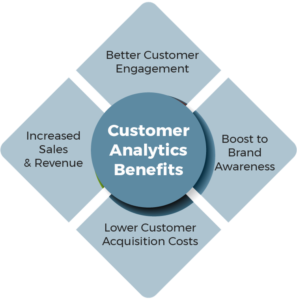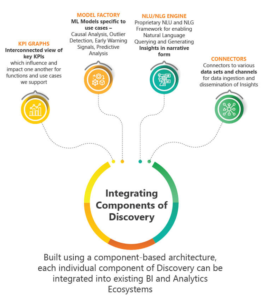Customer Behavior Analysis – Influencing Business Decisions and Outcomes
Customer analysis has grown much broader and deeper in the past few years. This period witnessed a constant evolution and adoption in customers’ lifestyles and preferences across the globe. The only way brands can cope with these fluctuations is by conducting extensive Customer Behavior Analysis. You must dig deeper and go beyond identifying customers to understand their needs, desires, choices, likes, and dislikes.
Dynamic customer journeys, numerous possible touchpoints, and enormous data sets pose a massive challenge to customer analysis. However, challenging it sounds, data is the hidden secret for most successful brands. Enterprises such as Netflix, gaining 75% of views through recommendations and its recommendation engine registering $1 billion annually, establish the value and impact of customer analytics.
Here is a closer look at the Customer Behavior Analysis and an effective implementation strategy to boost business outcomes.
Understanding Customer Behavior Analysis
Customer behavior analysis is a method to identify elements that propel your customers’ buying decisions. It defines a system that outlines how you collect, process, and analyze customer data to derive meaningful, actionable insights.
Behavior analytics goes beyond numbers like active users, subscribers, and likes to deliver insights into the factors influencing customers’ purchases. It helps to track and categorize what, why, when, and how customers take the actions that they do. You can leverage customer analytics tools that map your customers’ entire journey, better understand their interactions with your company, and offer them a hyper-personalized experience across channels. This helps your enterprise gain a significant competitive edge over the competition.
Why is Customer Analysis Imperative in the Present Business Scenario?
The rapidly evolving digital landscape is also increasing the complexity of user behavior. In such circumstances, discovering and leveraging precise and meaningful insights delivers incredible benefits to your business.
It allows you to predict customer value, personalize customers’ experiences, minimize churn, and improve retention. You can uncover insights specific to your business objectives, but behavioral analytics delivers several universal, meaningful, and tangible benefits.
- It helps in identifying opportunities and areas for improvement.
- You can elevate your marketing outcomes with extensively personalized messages.
- It facilitates the appropriate content generation and message timing for enhanced digital customer experience.
- It enables profound audience engagement, propelling higher conversion.
- You can significantly lower customer churn and boost their lifetime value.
A Harvard Business Review, Analytic Services study reveals that 58% of enterprises achieve significantly higher retention, and 44% enjoy growing ROI with new acquisitions. Similar resounding statistics from several global studies further affirm the potential of behavioral analysis.
8 Steps for a Successful Customer Analysis Execution
Customer behavior analytics is one of the most critical aspects of business operations. It influences the performance of every segment, including marketing, product design, customer services, and others. Consequently, it requires a well-crafted and constantly evolving strategy.
The following are a few crucial steps to analyze your outcomes, revisit the steps to optimize your plan, and meet fluctuating customers’ views and expectations.
1. Define the expected outcomes and goals you want to achieve
To get the desirable results from all your initiatives, you must define specific goals and work towards them. Similarly, for behavioral analysis, you need to determine your envisioned outcomes. It is essential to delineate what customer behavior aspects you want to learn about or encourage.
Establishing objectives helps you choose the KPIs that will define your success. For instance, you focus on KPIs such as retention rate, the number of support calls, and customer survey scores to increase customer satisfaction.
2. Identify and segregate your primary audience segments
Innovative tools assist you in learning deep insights beyond conventional demographics. You can analyze customers based on their behavior, such as shopping frequency, product usage, purchase motivation, and timing.
Identify and segment customers who can spend more, buy more frequently, or become brand ambassadors. Focusing your resources and efforts on such groups drives higher ROIs.
3. Determine key selling points for every audience segment
After identifying audience segments, you must pinpoint the factors driving your key audiences’ buying decisions. Customer feedback is an excellent source for discovering their unique selling points.
Ask questions like whether the purchase was spontaneous or purpose-driven, how they got to know about you, their opinion about pricing, and their experience with your products. Such questions reveal promising information about customers’ journeys and primary drivers.
4. Devise your customers’ journey and map all critical paths
Customer journey analytics involves jotting down the sequence of actions that resulted in customer interactions across touchpoints, conversions, onboarding, or retention. Analyze every touchpoint across all channels to determine critical paths to success.
A typical map on eCommerce channels would include steps like, search, explore and compare, choose and cart, checkout, and confirm the order. Intelligent behavioral analytics tools can recognize multiple paths and identify new ones while performing.
5. Establish data sources to gather maximum data
As buyer interactions spread over multiple channels, including mobile apps, websites, and in-store, rendering a multi-platform tool is the ideal means for gathering a panoramic view of customers.
A solution that collects and analyzes quantitative and qualitative data in structured, semi-structured, or unstructured form, delivers a significant competitive advantage and fuels innovation.
6. Unearth valuable insights with accurate customer analytics
Next, you can identify trends and discover valuable insights to optimize your actions and strategy. Try to find answers to questions like:
- What are the common touchpoints for a product’s sale?
- What is the most traversed path to purchase?
- Which perceived benefits or product features draw the customers the most?
- How do incentives, discount offers, and package selling influence customers’ buying habits?
- Who are your repeat buyers?
7. Implement insights in decision-making for result optimization
Now that you have all the information, it is time to connect the dots and translate your learnings into action. You can implement your findings in marketing, product updates, or enhancing services like delivery and customer support.
Utilize these insights to optimize results, improve performance, and get closer to your goals. For instance, increase the support crew for hours that register maximum complaints and queries or announce offers and discounts during the period when customer churn is high and conversions are low.
8. Assess your outcomes and replay
Behavioral analysis is not a one-off activity but an ongoing process. The idea is to constantly analyze your marketing and other activities, predict customers’ inclinations and drivers, and continuously adapt to the changes.
You may not see desired results from the first iteration. Tweak your approach and repeat. Try to incrementally improve and stay abreast of ever-changing market trends and customers’ preferences.
Customer Analysis with Course5
With intensively customer-centric markets, there is no substitute for knowing your audience for brands that wish to excel. Businesses must embrace Customer Behavior Analysis to gain deep insights into customers’ needs and preferences. Customer analytics service providers such as Course5 Intelligence offers AI-powered tools that can make this endeavor easy and effective with the help of automation.
Course5 Discovery, our AI-powered Augmented Analytics solution, leverages automation, ML, and related AI-based technologies, to facilitate faster access to contextual and actionable insights. There is a smart integration of both structured and unstructured data; with the capability to isolate trends and anomalies, identify causal factors, and showcase forecasts and predictions. The solution also offers prescriptive recommendations which are actionable in real time.
The increasing need to be data-driven and customer-focused is supported by the platform and its interconnected disciplines. The data collated from varied customer journeys across touchpoints elevate organizational insights and drive integrated and personalized omnichannel experiences. Discovery helps to deliver a superior experience by running customer experience analytics on a closed loop of customer data and enhancing internal processes to align with external objectives.
These features enable enterprises to understand the customer behavior of potential customers and existing customers, and optimize operations based on data-backed insights. The solution’s Natural Language Querying capabilities promote data democratization, and users with limited technical expertise can access insights generated in narrative form. Moreover, the platform fosters collaboration between business functions. This ensures that decision-makers across the organization are working with the same data and towards the same objectives.
Course5 Discovery is also compatible with cookie-less tracking, which is the primary agenda for executives today. The integrated web analytics capabilities focus on leveraging AI and ML technologies for increasing data transparency and privacy, maintaining analytics ethics, and eliminating bias when it comes to insight generation.
The solution is the future of Customer Data Platforms, with AI delivering value from data. It promotes an insights-first culture, where a better understanding of your customers influences better decision-making at every level, fostering greater control over customer acquisition, satisfaction, retention, and customer lifecycle value.
With effective analytical and predictive capabilities, our solution helps in delivering exceptional customer and market insights, helping you beat the competition and win over fluctuations and dynamism of the market and customers’ priorities.
Don’t miss our next article!
Sign up to get the latest perspectives on analytics, insights, and AI.






